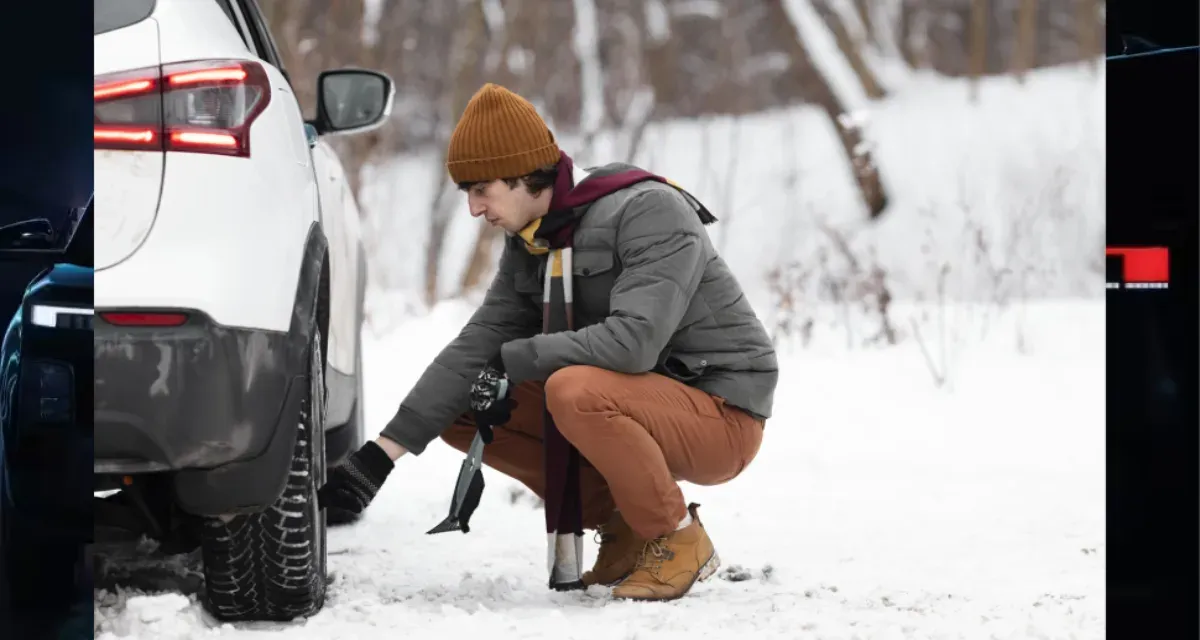

Winters have already approached. You are ready to face snowstorms and windy nights with blankets, caffeine, and flames, but did you ever wonder if you have to take out your car amidst a snowstorm that gets stuck in snow? Are you ready to face the situation or is your car prepared to tackle this issue?
Here are some pointers on handling situations both before and after they have occurred, ranging from driving techniques to using car props.
Choose the right tires for the right conditions.
Winter tyres, often referred to as snow tyres, are made particularly for cold weather and snow-covered roads. In contrast with all-season tyres, they have a different tread pattern and rubber compound, improving snow and ice traction. Snow tyres perform better than all-season tyres when temperatures drop below 45°F (7°C).
Also Read:- Best Way to Protect Car Paint During Winters
Keep a snow shovel in your vehicle
For clearing snow from the area around your tyres, a compact, flexible shovel can come in useful. An essential tool when your car gets stuck in the snow is a snow shovel. Making a path for movement is made easier by clearing snow from the area below and around the tyres. Shovelling around the tyres enhances grip and helps get unstuck, with the front of the car receiving special attention.
The Mechanism of Braking
Applying a tiny quantity of gas and gently applying the brakes will help a spinning te that is not moving when your car is stuck. By using a technique called "brake-torquing," you can reduce tyre spinning and direct power to a wheel with better traction. To prevent the brakes from overheating, use this method carefully as it's a delicate balance.
Also Read:- Tips to Maintain Your Car During Winters
Clearing Snow Under the Vehicle
When it's safe, shovel any snow out from under the car, giving special attention to the area around the line of exhaust. If the exhaust pipe is blocked, this reduces the possibility of carbon monoxide development within the vehicle.
Also Read:- How to Drive Vehicle in Heavy Fog
The Forward-and-Back Technique
Move your car into the lowest gear possible. Use the low-range gearing on your four-wheel drive SUV or pickup. Proceed a little bit ahead.
Now back up slowly. Avoid accelerating the engine. Put it in forward, stop, and then add a little gas. This may help you get enough grip to escape by driving down any loose snow.
Pay close attention. Remove your foot from the gas pedal right away if you hear any tyre spinning.
The Rocking Technique
Try "rocking" back and forth between the forward and reverse gears if your car is moving forward for a while before stopping. Just as the car begins to swing forward out of reverse, give it a little gas. You might get a sufficient push from this to leave. However, be advised that your gearbox may become overloaded by this sudden shifting. Try it no more than a couple of times or you will face serious harm.
Use Snow Chains
Snow chains enhance winter driving by providing extra grip on snowy or icy roads. They improve braking, acceleration, and steering control, reducing the risk of skidding and enhancing overall safety. Required in some regions during severe weather, snow chains are a crucial part of emergency preparedness for navigating challenging winter conditions.
Also Read:- How to Choose the Best Car Cleaning Products
Deflate Your Tyres a Little Bit
For short distances, driving with underinflated tyres improves grip because they have more rubber in contact with the ground. However, it's not safe to drive this way, and if the distance to the petrol station is great, it might harm your tyres.
Use Sand, Salt, or Traction Aids
Put something on the ground to provide grip if you're still whirling; it won't harm your tyres. If you want to back out, consider adding kitty litter or sand behind the drive tyres as well as in front of them.
Ask help from others to push the car
Occasionally, a little push from a few people will work wonders. Make sure above all that you only activate the gear that keeps drivers out of the way (use the forward gear only if the pusher is pushing your car from behind). As you gradually apply the gas, guide those around you to push on a three-count.
Do not use Antifreeze to melt snow
Antifreeze can get into gutters and end up in the water where it can poison aquatic life. It is toxic to kids, pets, and wild animals.